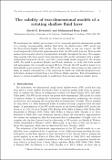Files in this item
The validity of two-dimensional models of a rotating shallow fluid layer
Item metadata
| dc.contributor.author | Dritschel, David Gerard | |
| dc.contributor.author | Jalali, Mohammad Reza | |
| dc.date.accessioned | 2021-02-12T00:39:12Z | |
| dc.date.available | 2021-02-12T00:39:12Z | |
| dc.date.issued | 2020-10-10 | |
| dc.identifier | 268469171 | |
| dc.identifier | 2947fc33-1ea9-4d04-a760-c3d19390a5da | |
| dc.identifier | 85090011171 | |
| dc.identifier | 000558733100001 | |
| dc.identifier.citation | Dritschel , D G & Jalali , M R 2020 , ' The validity of two-dimensional models of a rotating shallow fluid layer ' , Journal of Fluid Mechanics , vol. 900 , A33 . https://doi.org/10.1017/jfm.2020.487 | en |
| dc.identifier.issn | 0022-1120 | |
| dc.identifier.other | ORCID: /0000-0001-6489-3395/work/79917920 | |
| dc.identifier.uri | https://hdl.handle.net/10023/21418 | |
| dc.description | Funding: Support for this research has come from the UK Engineering and Physical Sciences Research Council (grant no. EP/H001794/1). | en |
| dc.description.abstract | We investigate the validity and accuracy of two commonly used two-dimensional models of a rotating, incompressible, shallow fluid layer: the shallow-water (SW) model and the Serre/Green–Naghdi (GN) model. The models differ in just one respect: the SW model imposes the hydrostatic approximation while the GN model does not. Both models assume the horizontal velocity is independent of height throughout the layer. We compare these models with their parent three-dimensional (3-D) model, initialised with a height-independent horizontal velocity, and with a mean height small compared to the domain width. For small to moderate Rossby and Froude numbers, we verify that both models well approximate the vertically averaged 3-D flow. Overall, the GN model is found to be substantially more accurate than the SW model. However, this accuracy is only achieved using an explicit reformulation of the equations in which the vertically integrated non-hydrostatic pressure is found from a novel linear elliptic equation. This reformulation is shown to extend straightforwardly to multi-layer flows having uniform density layers. | |
| dc.format.extent | 33 | |
| dc.format.extent | 2039470 | |
| dc.language.iso | eng | |
| dc.relation.ispartof | Journal of Fluid Mechanics | en |
| dc.subject | Shallow water flows | en |
| dc.subject | General fluid mechanics | en |
| dc.subject | Vortex dynamics | en |
| dc.subject | QA Mathematics | en |
| dc.subject | QC Physics | en |
| dc.subject | T-NDAS | en |
| dc.subject.lcc | QA | en |
| dc.subject.lcc | QC | en |
| dc.title | The validity of two-dimensional models of a rotating shallow fluid layer | en |
| dc.type | Journal article | en |
| dc.contributor.sponsor | EPSRC | en |
| dc.contributor.institution | University of St Andrews. Marine Alliance for Science & Technology Scotland | en |
| dc.contributor.institution | University of St Andrews. Scottish Oceans Institute | en |
| dc.contributor.institution | University of St Andrews. Applied Mathematics | en |
| dc.identifier.doi | https://doi.org/10.1017/jfm.2020.487 | |
| dc.description.status | Peer reviewed | en |
| dc.date.embargoedUntil | 2021-02-12 | |
| dc.identifier.grantnumber | EP/H001794/1 | en |
This item appears in the following Collection(s)
Items in the St Andrews Research Repository are protected by copyright, with all rights reserved, unless otherwise indicated.

